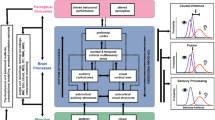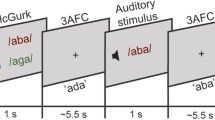Abstract
The insular cortex has long been associated with playing a critical role in perception especially of auditory and visual stimulus. Its role in auditory and visual perception has been well described through literature; however, the specific role of the insula is convoluted in the fact that it is difficult to study the specific function of the insula. It is hard to study its role because most of its complex functions are part of and rely on a complex network of multiple cortices. Imaging studies such as fMRI have been limited to measuring activation of these networks and have not been able to focus specifically on just measurements of the insula (Sterzer and Kleinschmidt, Brain Struct Funct 214:611–622, 2010). Some insights into studies have been conducted such as selective human stimulation of the insula. These studies have produced numerous responses such as somatosensory and auditory sensation (Mazzola et al., J Clin Neurophysiol 34:307–314, 2017). Its specific role is further complicated by its role in multimodal sensory integration. At times the insula’s major role of “decision-making” and audio/visual perception are synonymous. Some of its implicated roles in auditory perception are sound motion, frequency recognition, and pattern recognition (Mullan and Penfield, AMA Arch Neurol Psychiatry 81:269–284, 1959; Neff, Ann Otol Rhinol Laryngol 66:506–513, 1957; Colavita Physiol Behav 12:215–218, 1974). Some implicated roles of visual perception are word recognition and perception of facial intention (Dehaene et al., Nat Neurosci 4:752–758, 2001; Pessoa et al., Neuroimage 28:249–255, 2005). In this chapter, we will further investigate the insular cortex’s role in each of these functions as well as others that help shape what we consciously perceive visual and auditory stimulus.
Access this chapter
Tax calculation will be finalised at checkout
Purchases are for personal use only
Similar content being viewed by others
References
Lumer ED, Rees G. Covariation of activity in visual and prefrontal cortex associated with subjective visual perception. Proc Natl Acad Sci U S A. 1999;96(4):1669–73.
Bushara KO, Hanakawa T, Immisch I, Toma K, Kansaku K, Hallett M. Neural correlates of cross-modal binding. Nat Neurosci. 2003;6(2):190–5.
Gould van Praag CD, Garfinkel S, Ward J, Bor D, Seth AK. Automaticity and localisation of concurrents predicts colour area activity in grapheme-colour synaesthesia. Neuropsychologia. 2016;88:5–14.
Kim H, Hahm J, Lee H, Kang E, Kang H, Lee DS. Brain networks engaged in audiovisual integration during speech perception revealed by persistent homology-based network filtration. Brain Connect. 2015;5(4):245–58.
Sekuler R, Sekuler AB, Lau R. Sound alters visual motion perception. Nature. 1997;385(6614):308.
Benoit MM, Raij T, Lin FH, Jaaskelainen IP, Stufflebeam S. Primary and multisensory cortical activity is correlated with audiovisual percepts. Hum Brain Mapp. 2010;31(4):526–38.
Mullan S, Penfield W. Illusions of comparative interpretation and emotion; production by epileptic discharge and by electrical stimulation in the temporal cortex. AMA Arch Neurol Psychiatry. 1959;81(3):269–84.
Griffiths TD, Bench CJ, Frackowiak RS. Human cortical areas selectively activated by apparent sound movement. Curr Biol. 1994;4(10):892–5.
Ducommun CY, Murray MM, Thut G, Bellmann A, Viaud-Delmon I, Clarke S, et al. Segregated processing of auditory motion and auditory location: an ERP mapping study. NeuroImage. 2002;16(1):76–88.
Goldberg JM, Neff WD. Frequency discrimination after bilateral ablation of cortical auditory areas. J Neurophysiol. 1961;24:119–28.
Neff WD. Behavioral studies of auditory discrimination. Ann Otol Rhinol Laryngol. 1957;66(2):506–13.
Kelly JB, Whitfield IC. Effects of auditory cortical lesions on discriminations of rising and falling frequency-modulated tones. J Neurophysiol. 1971;34(5):802–16.
Colavita FB. Insular-temporal lesions and vibrotactile temporal pattern discrimination in cats. Physiol Behav. 1974;12(2):215–8.
Giraud AL, Kell C, Thierfelder C, Sterzer P, Russ MO, Preibisch C, et al. Contributions of sensory input, auditory search and verbal comprehension to cortical activity during speech processing. Cereb Cortex. 2004;14(3):247–55.
Augustine JR. Circuitry and functional aspects of the insular lobe in primates including humans. Brain Res Brain Res Rev. 1996;22(3):229–44.
Sterzer P, Kleinschmidt A. Anterior insula activations in perceptual paradigms: often observed but barely understood. Brain Struct Funct. 2010;214(5-6):611–22.
Lewis JW, Frum C, Brefczynski-Lewis JA, Talkington WJ, Walker NA, Rapuano KM, et al. Cortical network differences in the sighted versus early blind for recognition of human-produced action sounds. Hum Brain Mapp. 2011;32(12):2241–55.
Griffiths TD, Rees A, Witton C, Cross PM, Shakir RA, Green GG. Spatial and temporal auditory processing deficits following right hemisphere infarction. A psychophysical study. Brain. 1997;120(Pt 5):785–94.
Nguyen VT, Breakspear M, Hu X, Guo CC. The integration of the internal and external milieu in the insula during dynamic emotional experiences. NeuroImage. 2016;124(Pt A):455–63.
Vanneste S, Plazier M, der Loo E, de Heyning PV, Congedo M, De Ridder D. The neural correlates of tinnitus-related distress. NeuroImage. 2010;52(2):470–80.
Brooks JC, Zambreanu L, Godinez A, Craig AD, Tracey I. Somatotopic organisation of the human insula to painful heat studied with high resolution functional imaging. NeuroImage. 2005;27(1):201–9.
Banca P, Sousa T, Duarte IC, Castelo-Branco M. Visual motion imagery neurofeedback based on the hMT+/V5 complex: evidence for a feedback-specific neural circuit involving neocortical and cerebellar regions. J Neural Eng. 2015;12(6):066003.
Rousseau C, Fautrelle L, Papaxanthis C, Fadiga L, Pozzo T, White O. Direction-dependent activation of the insular cortex during vertical and horizontal hand movements. Neuroscience. 2016;325:10–9.
Sripada K, Lohaugen GC, Eikenes L, Bjorlykke KM, Haberg AK, Skranes J, et al. Visual-motor deficits relate to altered gray and white matter in young adults born preterm with very low birth weight. NeuroImage. 2015;109:493–504.
Dehaene S, Naccache L, Cohen L, Bihan DL, Mangin JF, Poline JB, et al. Cerebral mechanisms of word masking and unconscious repetition priming. Nat Neurosci. 2001;4(7):752–8.
Carmel D, Lavie N, Rees G. Conscious awareness of flicker in humans involves frontal and parietal cortex. Curr Biol. 2006;16(9):907–11.
Campbell R, MacSweeney M, Surguladze S, Calvert G, McGuire P, Suckling J, et al. Cortical substrates for the perception of face actions: an fMRI study of the specificity of activation for seen speech and for meaningless lower-face acts (gurning). Brain Res Cogn Brain Res. 2001;12(2):233–43.
Christensen MS, Ramsoy TZ, Lund TE, Madsen KH, Rowe JB. An fMRI study of the neural correlates of graded visual perception. NeuroImage. 2006;31(4):1711–25.
Deary IJ, Simonotto E, Meyer M, Marshall A, Marshall I, Goddard N, et al. The functional anatomy of inspection time: an event-related fMRI study. NeuroImage. 2004;22(4):1466–79.
Ploran EJ, Nelson SM, Velanova K, Donaldson DI, Petersen SE, Wheeler ME. Evidence accumulation and the moment of recognition: dissociating perceptual recognition processes using fMRI. J Neurosci. 2007;27(44):11912–24.
Wheeler ME, Petersen SE, Nelson SM, Ploran EJ, Velanova K. Dissociating early and late error signals in perceptual recognition. J Cogn Neurosci. 2008;20(12):2211–25.
Nelson SM, Dosenbach NU, Cohen AL, Wheeler ME, Schlaggar BL, Petersen SE. Role of the anterior insula in task-level control and focal attention. Brain Struct Funct. 2010;214(5-6):669–80.
Pessoa L, Padmala S, Morland T. Fate of unattended fearful faces in the amygdala is determined by both attentional resources and cognitive modulation. NeuroImage. 2005;28(1):249–55.
Thielscher A, Pessoa L. Neural correlates of perceptual choice and decision making during fear-disgust discrimination. J Neurosci. 2007;27(11):2908–17.
Calder AJ, Lawrence AD, Young AW. Neuropsychology of fear and loathing. Nat Rev Neurosci. 2001;2(5):352–63.
Krolak-Salmon P, Henaff MA, Isnard J, Tallon-Baudry C, Guenot M, Vighetto A, et al. An attention modulated response to disgust in human ventral anterior insula. Ann Neurol. 2003;53(4):446–53.
Reidy BL, Hamann S, Inman C, Johnson KC, Brennan PA. Decreased sleep duration is associated with increased fMRI responses to emotional faces in children. Neuropsychologia. 2016;84:54–62.
Cheng Y, Yang CY, Lin CP, Lee PL, Decety J. The perception of pain in others suppresses somatosensory oscillations: a magnetoencephalography study. NeuroImage. 2008;40(4):1833–40.
Critchley HD, Mathias CJ, Dolan RJ. Fear conditioning in humans: the influence of awareness and autonomic arousal on functional neuroanatomy. Neuron. 2002;33(4):653–63.
Adolphs R, Tranel D, Damasio AR. Dissociable neural systems for recognizing emotions. Brain Cogn. 2003;52(1):61–9.
Doi H, Morikawa M, Inadomi N, Aikawa K, Uetani M, Shinohara K. Neural correlates of babyish adult face processing in men. Neuropsychologia. 2017;97:9–17.
Moody TD, Sasaki MA, Bohon C, Strober MA, Bookheimer SY, Sheen CL, et al. Functional connectivity for face processing in individuals with body dysmorphic disorder and anorexia nervosa. Psychol Med. 2015;45(16):3491–503.
Author information
Authors and Affiliations
Corresponding author
Editor information
Editors and Affiliations
Rights and permissions
Copyright information
© 2018 Springer International Publishing AG, part of Springer Nature
About this chapter
Cite this chapter
Protas, M. (2018). Role of the Insula in Visual and Auditory Perception. In: Turgut, M., Yurttaş , C., Tubbs, R. (eds) Island of Reil (Insula) in the Human Brain. Springer, Cham. https://doi.org/10.1007/978-3-319-75468-0_16
Download citation
DOI: https://doi.org/10.1007/978-3-319-75468-0_16
Published:
Publisher Name: Springer, Cham
Print ISBN: 978-3-319-75467-3
Online ISBN: 978-3-319-75468-0
eBook Packages: MedicineMedicine (R0)




